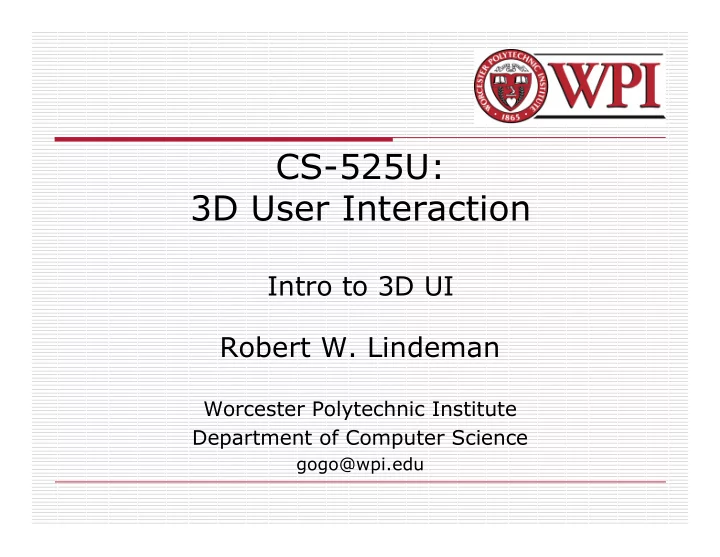

CS-525U: 3D User Interaction Intro to 3D UI Robert W. Lindeman Worcester Polytechnic Institute Department of Computer Science gogo@wpi.edu
Why Study 3D UI? � Relevant to real-world tasks � Can use familiarity to ease adaptation � Can increase realism of experience � Mature technology � Cheap, robust solutions � Need to create interface mappings � 3D interaction is difficult � Many VR/gaming systems lack necessary cues � Adapting WIMP techniques is not adequate R.W. Lindeman - WPI Dept. of Computer Science 2
Why Study 3D UI? (cont.) � Current approaches are either too simple or unusable � Since users have problems, dumb it down! � Need to be able to perform all actions though! � Ripe area for study � Very hot area of HCI � We know a lot about doing things in 2D � And also about doing things in the real world R.W. Lindeman - WPI Dept. of Computer Science 3
Sample Applications � Design and prototyping � Assembly � Ergonomics (test virtual prototype) � Psychiatric treatment � Phobias � Post-traunatic stress disorders � Scientific visualization � Explore 3D data sets � Collaborative work � Tools, gestures, madia control R.W. Lindeman - WPI Dept. of Computer Science 4
A Brief History � Before 1980 � Mostly keyboard input � Display for text � After first Graphical User Interfaces (GUIs) � Added complexity � Growth in HCI studies R.W. Lindeman - WPI Dept. of Computer Science 5
A Brief History (cont.) � HCI draws on � Perception � Cognition � Linguistics � Human factors � Ethnography � Graphics design � Computer science � … R.W. Lindeman - WPI Dept. of Computer Science 6
A Brief History (cont.) � Technology developments also drove growth � Flight simulators � 3D Graphics � Augmented Reality (AR) � Virtual Reality (VR) � Flight R.W. Lindeman - WPI Dept. of Computer Science 7
Birth of Virtual Reality � The Ultimate Display paper by Ivan Sutherland (1965) � Sutherland’s HMD (1968) � Jaron Lanier VPL DataGlove (1985) � Jim Foley's Scientific American paper (1987) R.W. Lindeman - WPI Dept. of Computer Science 8
Basic Interaction Tasks in VR (Bowman et al. ) � Object Selection � What do I want to manipulate? � Object Manipulation � How can I manipulate it? � Navigation � Wayfinding: How do I know where I am, and how to get where I am going? � Travel: How do I get there? (locomotion) � System Control � How do I change system parameters? � Symbolic Input � Inputting text and numbers R.W. Lindeman - WPI Dept. of Computer Science 9
Oh, I forgot One (Lindeman) � Killing R.W. Lindeman - WPI Dept. of Computer Science 10
Dealing with Objects � Problems � Ambiguity � Distance � Selection Approaches � Direct / enhanced grabbing � Ray-casting techniques � Image-plane techniques � Manipulation Approaches Courtesy: D. Bowman � Direct position / orientation control � Worlds in miniature � Skewers � Surrogates R.W. Lindeman - WPI Dept. of Computer Science 11
Navigation: Wayfinding � People get lost/disoriented easily � Traditional tools � Maps (North-up vs. Forward-up) � Landmarks � Spoken directions � Non-traditional � Callouts � Zooming Images: http://vehand.engr.ucf.edu/handbook/Chapters/Chapter28/Chapter28.html R.W. Lindeman - WPI Dept. of Computer Science 12
Navigation: Travel � Problems � Limited physical space, unlimited virtual space � Cables � Approaches � Fly where you point/look � Treadmills � Walking in place � Big track ball CLIP Image: www.virtusphere.com R.W. Lindeman - WPI Dept. of Computer Science 13
System Control � Need to manipulate widgets � Lighting effects � Object representation � Data filtering � Approaches � Floating windows � Hand-held windows � Gestures � Menus on fingers R.W. Lindeman - WPI Dept. of Computer Science 14
System Control Examples Courtesy: R. Lindeman Courtesy: D. Bowman R.W. Lindeman - WPI Dept. of Computer Science 15
User, Task & Environment � The "optimal" interface will depend on the capabilities of the user , the nature of the task being performed, and the constraints of the environment . � User � Dexterity, level of expertise � Task � Granularity and complexity of task � Environment � Stationary, moving, noisy, etc. R.W. Lindeman - WPI Dept. of Computer Science 16
Direct Manipulation Courtesy: Virginia Tech R.W. Lindeman - WPI Dept. of Computer Science 17
Can We Do WIMP in VR? Courtesy: Virginia Tech R.W. Lindeman - WPI Dept. of Computer Science 18
Desktop Interaction: SensAble PHANToM http://www.sensable.com/ R.W. Lindeman - WPI Dept. of Computer Science 19
Wearable Interaction with Haptics: Immersion CyberGrasp http://www.immersion.com/ R.W. Lindeman - WPI Dept. of Computer Science 20
Wearable Interaction: Rob's Hand-Held Windows http://www.cs.wpi.edu/~gogo/ R.W. Lindeman - WPI Dept. of Computer Science 21
How Do We Do Menus? Courtesy: Virginia Tech R.W. Lindeman - WPI Dept. of Computer Science 22
Interface Devices Courtesy: Virginia Tech R.W. Lindeman - WPI Dept. of Computer Science 23
Augmented Reality (AR) Courtesy: Virginia Tech R.W. Lindeman - WPI Dept. of Computer Science 24
Applications � Data perceptualization � Map variables to tactors � Spatial awareness � Driver warning system (vibrotactile Bott's dots) � Navigational aid � Firefighter guidance � Non-verbal communication � Map hand signals to vibrotactile patterns R.W. Lindeman - WPI Dept. of Computer Science 25
Recommend
More recommend